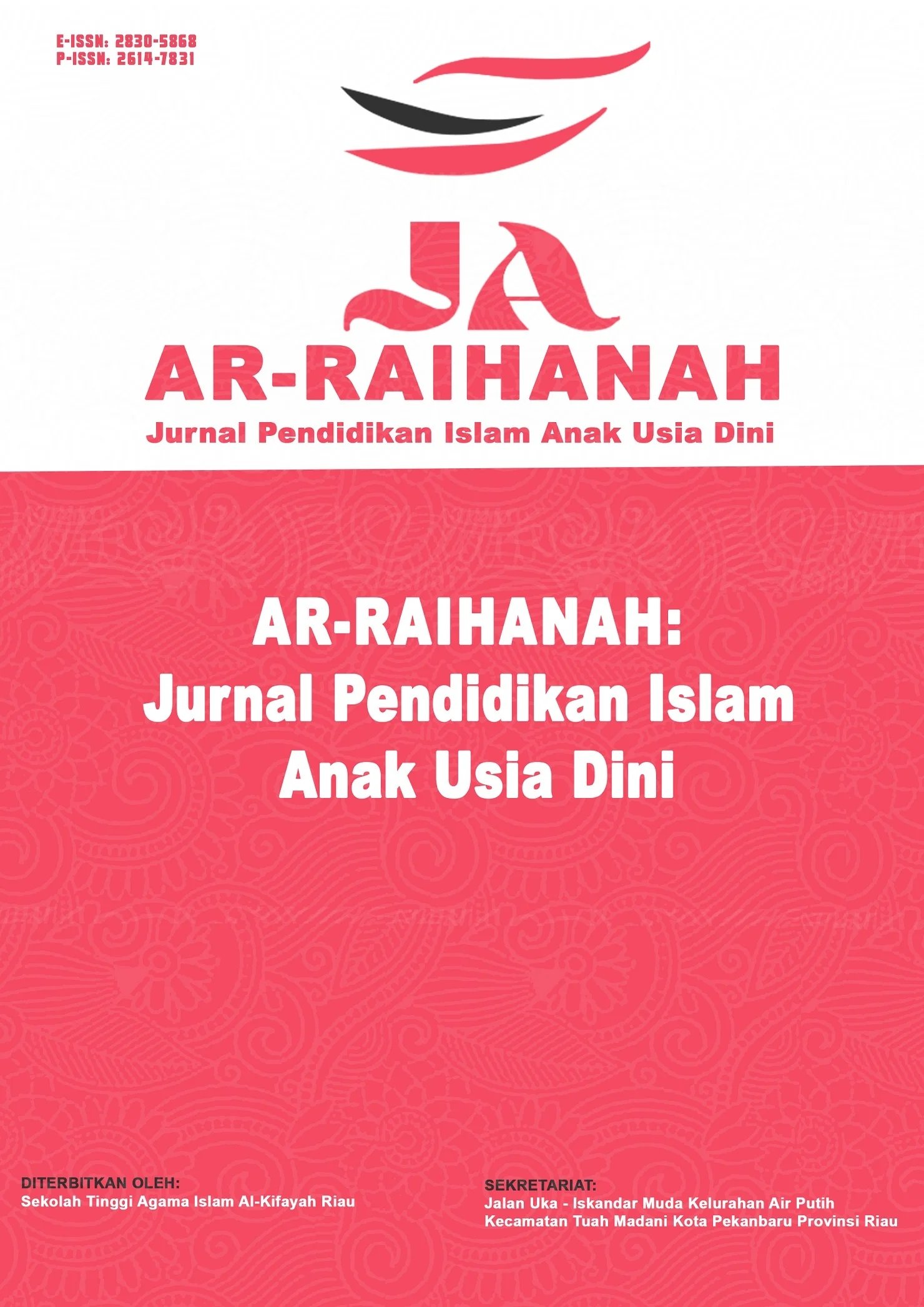Pengaruh Kegiatan Ninja Warrior Kids Terhadap Perkembangan Motorik Kasar Anak Usia 5-6 Tahun Di Taman Kanak-Kanak Yayasan Amalan Kota Padang
DOI:
https://doi.org/10.53398/arraihanah.v5i2.684Keywords:
Ninja Warrior Kids, Early Childhood, Motor Development, Physical ActivityAbstract
This study aims to determine the effect of Ninja Warrior Kids activities on gross motor development of children aged 5-6 years in learning activities at Amalan Foundation Kindergarten, Padang City. This study uses a quantitative approach with a quasi-experimental method. The population in this study were all Amalan Foundation Kindergarten students in the 2024/2025 school year. The sampling technique used was cluster sampling, with Bintang class as the experimental group (12 children) and Bulan class as the control group (12 children). The experimental group received treatment in the form of Ninja Warrior Kids activities, while the control group followed the traditional game of engklek. Data were obtained through pre-test and post-test which were analyzed using the independent sample t-test statistical test. The results showed that there was a significant influence between Ninja Warrior Kids activities on children's gross motor development. This is evidenced by the significance value (2-tailed) of 0.017 < 0.05. Thus, it can be concluded that Ninja Warrior Kids activities are effective as an alternative learning media to develop gross motor skills in early childhood. The findings of this research have significant implications for early childhood education, particularly in enhancing motor development through engaging physical activities. By integrating Ninja Warrior Kids activities into the curriculum, educators can promote physical activity that not only fosters gross motor skills but also encourages social interaction and teamwork among children. This experimental research highlights the importance of innovative approaches in early childhood education, suggesting that such activities can be a valuable addition to traditional learning methods
References
Adolph, K. E., & Franchak, J. M. (2017). The development of motor behavior. WIREs Cognitive Science, 8(1–2). https://doi.org/10.1002/wcs.1430
Bredekamp, S. (2019). Effective practices in early childhood education: Building a foundation (4th ed.). Pearson.
Gallahue, D. L., & Donnelly, F. C. (2021). Developmental physical education for all children (6th ed.). Human Kinetics.
Gallahue, D. L., & Ozmun, J. C. (2019). Understanding motor development: Infants, children, adolescents, adults (8th ed.). McGraw-Hill Education.
Guthold, R., Stevens, G. A., Riley, L. M., & Bull, F. C. (2020). Global trends in insufficient physical activity among adolescents: A pooled analysis of 298 population-based surveys with 1.6 million participants. The Lancet Child & Adolescent Health, 4(1), 23–35. https://doi.org/10.1016/S2352-4642(19)30323-2
Hasibuan, N. R. F., Fauzi, T., & Novianti, R. (2020). Pengaruh kegiatan senam irama terhadap kecerdasan kinestetik pada anak kelompok B TK Mustabaqul Khoir Palembang. Jurnal Pendidikan Anak, 9(2), 118–123. https://doi.org/10.21831/jpa.v9i2.33564
Kementerian Pendidikan, Kebudayaan, Riset, dan Teknologi Republik Indonesia. (2022). Kurikulum Merdeka PAUD - Elemen Jati Diri.
Kusuma, D. W. Y., & Hartono, M. (2020). Indonesian Ninja Warrior for physical education in elementary school. Proceedings of the 5th International Conference on Physical Education, Sport, and Health (ACPES 2020). https://www.atlantis-press.com/article/125941481.pdf
Libertus, K., & Hauf, P. (2017). Editorial: Motor skills and their foundational role for perceptual, social, and cognitive development. Frontiers in Psychology, 8. https://doi.org/10.3389/fpsyg.2017.00301
Logan, S. W., Kipling Webster, E., Getchell, N., Pfeiffer, K. A., & Robinson, L. E. (2015). Relationship between fundamental motor skill competence and physical activity during childhood and adolescence: A systematic review. Kinesiology Review, 4(4), 416–426. https://doi.org/10.1123/kr.2013-0012
Lopes, V. P., Rodrigues, L. P., Maia, J. A. R., & Malina, R. M. (2011). Motor coordination as a predictor of physical activity in childhood. Scandinavian Journal of Medicine & Science in Sports, 21(5), 663–669. https://doi.org/10.1111/j.1600-0838.2009.01027.x
Maghfiroh, L., Wulandari, R. T., & Damayani, R. (2020). Penerapan permainan lompat ceria untuk meningkatkan kemampuan fisik motorik kasar anak usia 5-6 tahun di TK PKK 3 Gunungsari Pasuruan. Jurnal Pendidikan Anak Usia Dini, 2(1), 1–10. http://repository.um.ac.id/id/eprint/8608
Ningrum, M. A., Niya, L. D. C., & Hamidah, M. (2023). Meningkatkan kemampuan motorik kasar melalui permainan halang rintang pada anak usia dini. Jurnal Obsesi: Jurnal Pendidikan Anak Usia Dini, 7(5), 5133–5142. https://doi.org/10.31004/obsesi.v7i5.4868
Okely, A. D., Kariippanon, K. E., Guan, H., Taylor, E. K., Suesse, T., Cross, P. L., Chong, K. H., Suherman, A., Turab, A., Staiano, A. E., Ha, A. S., El Hamdouchi, A., Baig, A., Poh, B. K., Del Pozo-Cruz, B., Chan, C. H. S., Nyström, C. D., Koh, D., Webster, E. K., & Draper, C. E. (2021). Global effect of COVID-19 pandemic on physical activity, sedentary behaviour and sleep among 3- to 5-year-old children: A longitudinal study of 14 countries. BMC Public Health, 21(1), 940. https://doi.org/10.1186/s12889-021-10852-3
Piaget, J. (1952). The origins of intelligence in children. Norton.
Pica, R. (2020). Active learning across the curriculum: Teaching the way they learn. Redleaf Press.
Santrock, J. W. (2021). Children (14th ed.). McGraw-Hill Education.
Sugiyono. (2017). Metode penelitian pendidikan: Pendekatan kuantitatif, kualitatif, dan R&D. Alfabeta.
Sulistiawati, R. (2019). Pengembangan kemampuan motorik kasar melalui gerak lokomotor pada anak usia dini. Jurnal Pendidikan Anak.
Downloads
Published
How to Cite
Issue
Section
License
Copyright (c) 2025 Ar-Raihanah: Jurnal Pendidikan Islam Anak Usia Dini

This work is licensed under a Creative Commons Attribution-NonCommercial-ShareAlike 4.0 International License.







.png)




